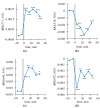Influence of Local Burning on Difference Reflectance Indices Based on 400-700 nm Wavelengths in Leaves of Pea Seedlings
- PMID: 33925343
- PMCID: PMC8146762
- DOI: 10.3390/plants10050878
Influence of Local Burning on Difference Reflectance Indices Based on 400-700 nm Wavelengths in Leaves of Pea Seedlings
Abstract
Local damage (e.g., burning) induces a variation potential (VP), which is an important electrical signal in higher plants. A VP propagates into undamaged parts of the plant and influences numerous physiological processes, including photosynthesis. Rapidly increasing plant tolerance to stressors is likely to be a result of the physiological changes. Thus, developing methods of revealing VP-induced physiological changes can be used for the remote sensing of plant systemic responses to local damage. Previously, we showed that burning-induced VP influenced a photochemical reflectance index in pea leaves, but the influence of the electrical signals on other reflectance indices was not investigated. In this study, we performed a complex analysis of the influence of VP induction by local burning on difference reflectance indices based on 400-700 nm wavelengths in leaves of pea seedlings. Heat maps of the significance of local burning-induced changes in the reflectance indices and their correlations with photosynthetic parameters were constructed. Large spectral regions with significant changes in these indices after VP induction were revealed. Most changes were strongly correlated to photosynthetic parameters. Some indices, which can be potentially effective for revealing local burning-induced photosynthetic changes, are separately shown. Our results show that difference reflectance indices based on 400-700 nm wavelengths can potentially be used for the remote sensing of plant systemic responses induced by local damages and subsequent propagation of VPs.
Keywords: pea leaves; photosynthetic response; reflectance indices; remote sensing; variation potential.
Conflict of interest statement
The authors declare no conflict of interests. The funders had no role in the design of the study; in the collection, analyses, or interpretation of data; in the writing of the manuscript, or in the decision to publish the results.
Figures






References
-
- Trebacz K., Dziubinska H., Krol E. Electrical signals in long-distance communication in plants. In: Baluška F., Mancuso S., Volkmann D., editors. Communication in Plants. Neuronal Aspects of Plant Life. Springer; Berlin/Heidelberg, Germany: New York, NY, USA: 2006. pp. 277–290.
-
- Gallé A., Lautner S., Flexas J., Fromm J. Environmental stimuli and physiological responses: The current view on electrical signaling. Environ. Exp. Bot. 2015;114:15–21. doi: 10.1016/j.envexpbot.2014.06.013. - DOI
Grants and funding
LinkOut - more resources
Full Text Sources

